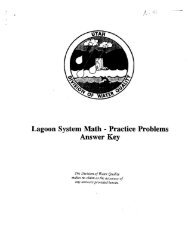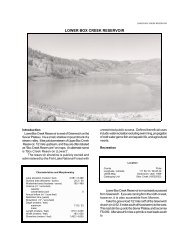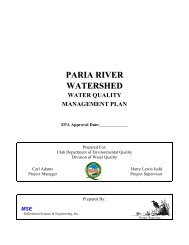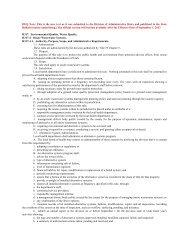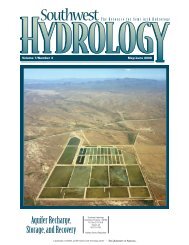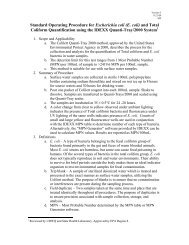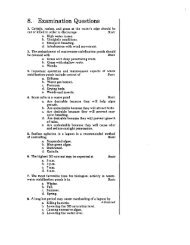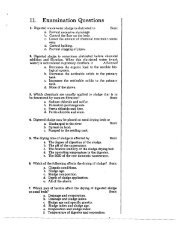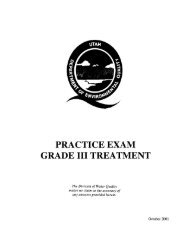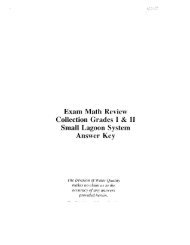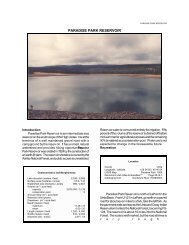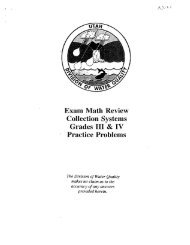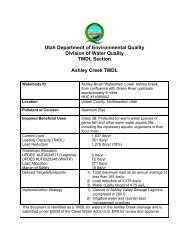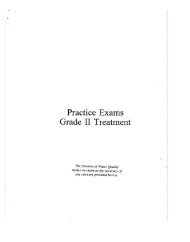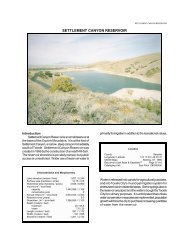Silver Creek - Division of Water Quality - Utah.gov
Silver Creek - Division of Water Quality - Utah.gov
Silver Creek - Division of Water Quality - Utah.gov
Create successful ePaper yourself
Turn your PDF publications into a flip-book with our unique Google optimized e-Paper software.
<strong>Silver</strong> <strong>Creek</strong> <strong>Water</strong>shed TMDL Final Report<br />
As the terrain flattens, flow velocities in the stream and from run<strong>of</strong>f events decrease and begin to<br />
deposit the sediments from the upper watershed. Increased sediment deposition leads to<br />
increased contamination at these locations (Park City, <strong>Silver</strong> Maple Claims, Meadow area).<br />
The middle to lower reaches (Flood Plain, Richardson Flats, Meadow area) are substantially<br />
flatter than the upstream reaches. These areas were used for tailing reprocessing and disposal.<br />
The landscape is littered with mounds <strong>of</strong> contaminated mine tailings. The meadow area from just<br />
below Richardson Flat to Atkinson is nearly completely covered with tailings. The stream<br />
channel runs through tailings for a stretch <strong>of</strong> approximately 4 miles in this meadow area. The<br />
contamination processes that are visually apparent include direct storm water run<strong>of</strong>f to the creek,<br />
direct stream contact with tailings and shallow ground water contact with tailings. The ground<br />
water table is fairly high and is believed to exchange freely with water in <strong>Silver</strong> <strong>Creek</strong>, thus<br />
increasing the contaminant load in the stream.<br />
The <strong>Silver</strong> <strong>Creek</strong> WRF is a relatively small source <strong>of</strong> zinc loading currently as it contributes<br />
approximately only 598 <strong>of</strong> the 12,000 lbs per year <strong>of</strong> zinc passing the Atkinson Station (See<br />
Table 8). This represents 5 percent <strong>of</strong> the total load at Atkinson. Additionally, none <strong>of</strong> the<br />
samples for zinc obtained at the WRF in the 12-year period <strong>of</strong> this study exceeded the water<br />
quality standard for zinc. However, once best management practices are implemented in <strong>Silver</strong><br />
<strong>Creek</strong>, the relative contribution <strong>of</strong> the WRF will become more significant. If growth projections<br />
for the WRF are met, the discharge volume will grow from a current value <strong>of</strong> 1.4 MGD to 2.0<br />
MGD in the next 10 years. This would result in the WRF contributing some 628 lbs. <strong>of</strong> zinc<br />
annually to a combined load at Atkinson after BMP implementation <strong>of</strong> 4,810 lbs. (13% <strong>of</strong> the<br />
combined load)<br />
Cadmium levels have consistently been below the detection limit, indicating that the WRF does<br />
not appear to be a contributor <strong>of</strong> cadmium to <strong>Silver</strong> <strong>Creek</strong>.<br />
The last stream reach (to Wanship) has no tailings or other sources <strong>of</strong> contaminants besides<br />
sediment loads within the stream. This reach is the only section <strong>of</strong> stream that exhibits reducing<br />
levels <strong>of</strong> contaminants, again probably due to contaminants being adsorbed or precipitated.<br />
Page 38



